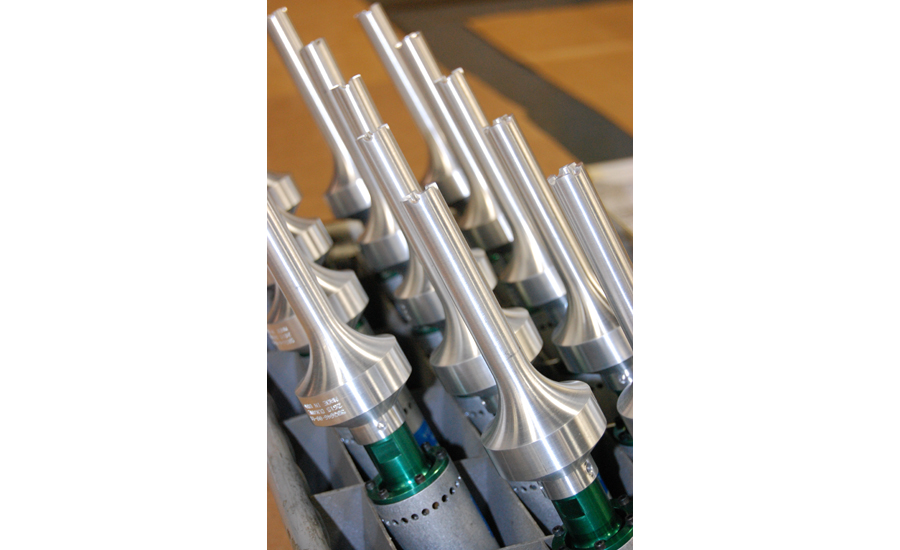This year, I’ve had the great fortune of visiting many of ASSEMBLY magazine’s customers. So far, I’ve been to Michigan, Connecticut, Rhode Island and Pennsylvania. But, not of all my visits have been so far away. In fact, the most recent was just around the corner from my house: Dukane Corp.’s Intelligent Assembly Systems Division.
Located in St. Charles, IL, a far western suburb of Chicago, Dukane manufactures plastics assembly equipment, including ultrasonic welders, vibration welders, spin welders, hot-plate welders, laser welders, and staking presses. Everything is built to order.
Like many of ASSEMBLY’s customers these days, the shop floor was crowded with projects and buzzing with activity. Not surprisingly, there were a lot of automotive applications on the shop floor (lights, ducts, interior components), but there were appliance, medical and electrical equipment applications, too.
“We’ve grown quite a lot,” says Michael J. Johnston, president of the IAS Division.
Dukane maintains a mammoth machine shop, which enables the company to manufacture transducers, horns, fixtures and other components in house. Horns are typically made from titanium or aluminum. Fixtures are made from aluminum, steel or stainless steel. Keeping manufacturing in-house gives Dukane a competitive advantage, says Johnston. If customers need to tweak their tooling during run-off testing, they don’t have to wait days or weeks for it to be returned. It can be done right then.
“We used to design tooling and fixtures directly off the part,” says Johnston. “Today, it’s all about time to market, and we design tooling and fixtures from the CAD files of the parts.
“It’s always a good idea to get us involved in a plastics assembly project long before the molds are cut. We can help customers design their parts for a more robust and error-free assembly process.”
Run-off typically requires about 25 samples. Sophisticated “design of experiments” testing will require more samples.
The company has multiple laboratories for testing tooling, evaluating new plastic part designs, troubleshooting existing processes, and even characterizing new resin formulas.
Not long ago, Dukane created a new standard test part, the Industrial Standard Test Part (ISTeP). Previous experimentation had shown that the industry standard test part—a plastic I-beam—was prone to warp and sink, which made consistent measurements difficult to achieve.
The ISTeP was developed to facilitate precise height measurement and consistent pull testing results. Its round design prevents “zippering,” in which one side of an I-beam test part fractures first, leading to a peel effect on the remaining weld. The mold design also includes an insert to allow molding of various joint designs.
While the original ISTeP was molded from clear polycarbonate, Dukane has also produced an opaque version. (A clear top can be paired with an opaque bottom for testing laser welding processes.)
Cavity 15
You never know what testing will find. Johnston recalls a case involving a manufacturer of electrical connectors. The company was using an ultrasonic plastic welder to assemble a high-volume product. The process ran smoothly for a long time, but then, out of the blue, the reject rate ticked up.
Engineers at the company were baffled. Random samples of the parts were in spec. What could be going on? Believing the problem was with the welder, they called Dukane for help.
At first, Dukane’s troubleshooters were just as puzzled. The tooling was fine. The welding parameters were fine. And yet rejects were occurring seemingly at random.
It was then that a Dukane engineer realized the parts were being produced with a multicavity mold. Fortunately, each cavity was engraved with a unique identification code, so Dukane’s engineers were able to sort sample parts according to which mold cavity they came from.
When the weld tests were repeated on each batch of segregated parts, the problem became clear. Parts from every cavity welded perfectly—except those from cavity 15. When the faulty cavity was repaired, the process ran smoothly once again.
“Whenever something goes wrong with a plastics joining process, it’s usually related to the parts,” says Johnston. “Maybe a mold wears out. Maybe the composition of the plastic is different. But something changes.”
We Will Sell No Transducer Before Its Time
The heart of an ultrasonic welder is the “stack,” which consists of the transducer, booster and horn. Also known as the converter, the transducer converts high-frequency electrical energy into high-frequency mechanical vibrations.
The converter contains several piezoelectric ceramic discs sandwiched under pressure between two metal blocks. Between each disc is a thin metal plate, which forms the electrode. When a sinusoidal electrical signal is fed to the transducer via the electrodes, the discs expand and contract, producing axial vibrations.
Once assembled, the transducers are aged before testing and final assembly. The properties of piezoelectric materials can change with time and pressure, so a bit of time on the shelf prior to testing will identify nonconforming material.
Plastics Assembly
A World of Plastics Joining at Dukane


Recent Comments
Helpful for Trainees
Cable Assembly Manufacturers
Huawei for manufacturing?
should have a scanner and then 3D print the repair
IPC-A-610 and IPC-j-std-001